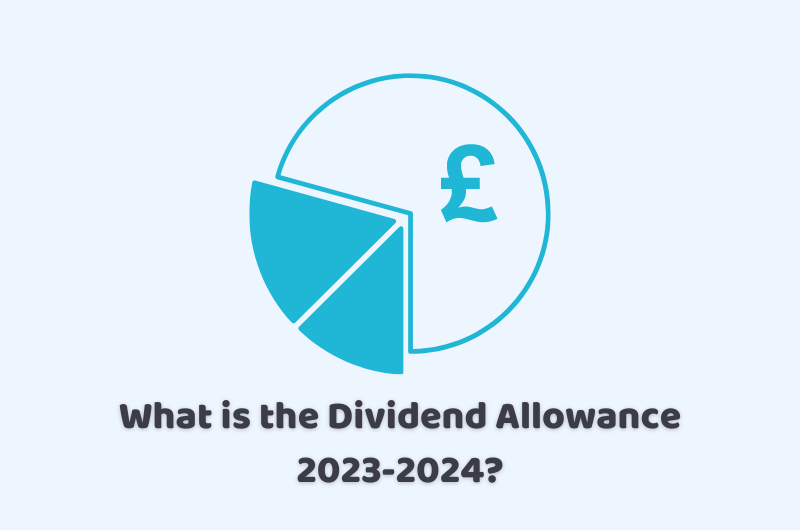
18/07/2023Dividend Allowance
An inevitable source of income is known as dividends in the UK. However, there is a tax to be paid on the earnings coming from the dividends but the tax rate implemented on this is different from the income tax rate. Which makes things a little confusing for common people to understand. This guide will help to cater for the frequently asked questions in this regard. This includes the discussion of what is dividend allowance, who is in a position to receive the dividend allowance, and how much is the dividend allowance. Let us get further delved into the discussion to know more.
Reach out to our smart and clever-minded guys to get an understanding of the tax set of rules in the UK queries answered quickly. We will help to understand your queries instantly.
What is a Dividend Allowance?
A dividend allowance is a tax-free allowance that allows individuals to receive a certain amount of dividend income each year without paying tax. In the UK, the dividend allowance was introduced in April 2016 and is available to all taxpayers, regardless of their income.
Moreover, the company’s board of directors determines the dividend amount which can vary depending on the company’s financial performance and other factors. Dividends are usually paid on a regular basis, such as quarterly or annually, and are taxable income for the shareholders who receive them.
Who can Receive a Dividend Allowance?
In the UK, the dividend allowance is available to all taxpayers, regardless of their income. This means that anyone who receives dividend income from UK companies or from overseas companies that are based in countries that have a tax treaty with the UK can benefit from the allowance.
However, it’s important to note that the dividend allowance is a personal allowance, which means that it cannot be transferred between spouses or partners. Each individual is entitled to their own dividend allowance, and if they receive dividend income above this amount, they may be liable to pay tax on the excess.
How Much Tax will I Pay on my Dividends?
In the UK, the amount of tax you will pay on dividend income above the dividend allowance depends on your income tax band. For the 2021-22 tax year, the rates are:
Basic rate taxpayers pay 8.75% on dividends, higher rate taxpayers pay 33.75%, and additional rate taxpayers pay 39.35%. It’s important to note that tax rates and allowances can change from year to year, so it’s always a good idea to check the latest information from HMRC.
What Tax-Free Allowances Can I Use Against Dividends?
In the UK, you can use the following tax-free allowances against dividends:
1- Personal Allowance: This is an allowance that everyone is entitled to, which is currently £12,570 for the tax year 2023-24. This means that you can earn up to £12,570 in dividends tax-free.
2- Dividend Allowance: This is an allowance specifically for dividends, which is currently £1,000 for the tax year 2023-24. This means that you can receive up to £1,000 in dividends tax-free.
What is the Tax-Free Personal Allowance in 2023-24?
The amount of personal allowance is known to be the extent of earnings that is tax-free and you do not have any tax implications for such an amount of earnings. Moreover, in the tax year 2023-24, the amount of personal allowance is £12,570 before you come under the liability to pay tax on your earnings.
Moreover, this kind of tax is allowed once within the duration of a tax year. Let us take the example of the amount of income you are getting is £10,000, if it is the only amount of income you have earned within one tax year, you are not liable to pay tax on it.
How Much is the Dividend Allowance in the Tax Year 2023-24?
A dividend allowance is known to be the amount of dividends that you can earn within the limit of one tax year without paying any tax on it. If the dividends are not reached the limit of the allowance threshold, the amount of money you are earning will be tax-free.
How and When Do I Pay Dividend Tax?
In the UK, you need to pay tax on dividends if they exceed your tax-free allowances. The tax rates for dividends depend on your income tax band. For the tax year 2023-24, the tax rates for dividends are:
- 0% on the first £1,000 of dividends
- 8.75% on dividends within the basic rate band (£12,571 to £50,270)
- 33.75% on dividends within the higher rate band (£50,271 to £125,139)
- 39.35% on dividends within the additional rate band (over Over £125,140)
To pay dividends tax, you will need to report the dividend income on your tax return. If you’re employed and pay tax through PAYE, you may need to pay additional tax on your dividend income through a Self Assessment tax return. The deadline for filing your tax return is usually the 31st of January following the end of the tax year.
The Bottom Line
Now that you have gathered a fair amount of information regarding the dividend allowance in the tax year 2023-24, we can bring the discussion towards wrapping up. As you need to pay tax on dividends if they exceed your tax-free allowances, and the tax rates for dividends depend on your income tax band. To pay dividends tax, you will need to report the dividend income on your tax return and pay any tax due. The deadline for this act of filing the tax return is usually the end of January.
Our team of professional members loves to hear out your business problems and find out the possible and suitable solutions quickly to the reporting in the UK. Contact us now.
Disclaimer: The information about the dividend allowance provided in this blog includes text and graphics of general nature. It does not intend to disregard any of the professional advice.
